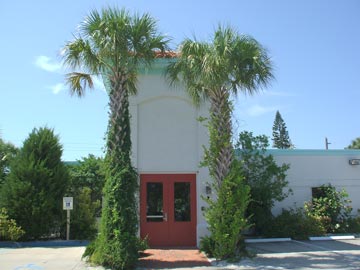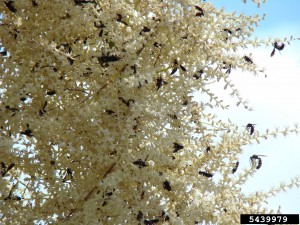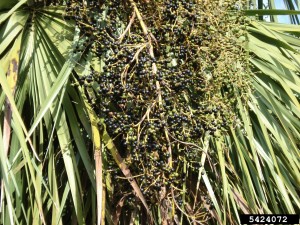and bring home the beauty of real Florida.
Visit FloridaNativeNurseries.org
 Sabal palms in full booted glory, with vines running up them, frame the entry at The Studio on Anna Maria Island. Landscape design by Michael Miller of Perfect Environs.
Sabal palms in full booted glory, with vines running up them, frame the entry at The Studio on Anna Maria Island. Landscape design by Michael Miller of Perfect Environs.by Richard Moyroud, Mesozoic Landscapes and FANN founding member
The Sabal Palm is one of our most common and least appreciated native palms. Sabal palmetto, our state tree, is a medium-sized fan palm found throughout Florida (except for the interior of the Panhandle). Exceedingly drought tolerant, salt tolerant, cold hardy, pest and disease free, the Sabal Palm is a foolproof choice for any Florida landscape. It thrives on available rainfall and the meager nutrients found in Florida’s sandy soils, making it a perfect choice for sustainable landscapes. This resilient tree endures fire, flood, freeze, and hurricane, and recovers remarkably well after being dug from the wild, carried across the state, and then planted into harsh urban sites. Our demand for Sabal Palms in landscape plantings is having a noticeable effect on wild populations, and we need to better understand the status and future of this stalwart native.
One of the most intriguing questions in palm biology is the rate of growth of various species, especially in the wild. Age and growth rates of sabal palm have been studied by the University of Florida, and preliminary results indicate some startling news: under average conditions in the wild, plants require ten to fifteen years or more from seed to the first sign of a trunk at ground level; thereafter, trunks will grow about six inches per year. This means that a Sabal Palm with 20 feet of trunk is at least 50 years old! We often see trees in landscape jobs that are 30 or 40 feet tall, or 70 to 95 years old! All of these trees are being harvested from the wild on private lands, and the relatively low fee paid to the landowner does not reflect their true value. Will there be trees this old available a decade from now?
Growing Sabal Palms is a long slow process, requiring patience, persistence, and dedication to the future of Florida. FANN members are propagating Sabal Palm from seed, and both container-grown and field-grown plants are available and are being used as landscapers discover them. Very small Sabal Palms with less than three feet of trunk are almost impossible to transplant but are actually quite attractive at this size and usable in the landscape. Sabal palms of this size can be moved successfully from nurseries which have grown the plants in special fiber bags to confine the roots.
For sustainable landscapes:

Pollinators swarm Sabal Palm flowers. Photo by Rebekah D. Wallace, University of Georgia, Bugwood.org
Ecosystem in a tree: Seminole and Miccosukee Indians refer to the Sabal Palm as the “tree of life,” for it has provided them shelter, food, tools, utensils, and fiber for baskets and netting. The Sabal Palm often hosts other plants in its “boots,” including Strangler Fig, Wild Grape, Virginia Creeper, and a variety of beautiful threatened and endangered ferns. The Sabal Palm also shelters and supplies nesting material to Bats, Caracaras, Cardinals, Crows, Doves, Flycatchers, Gnatcatchers, Hawks, Hummingbirds, Kinglets, Mockingbirds, Shrikes, Wrens, Opossums, Raccoons, Squirrels, Snakes, Tree Frogs, Lizards, and a variety of Insects.

After flowering, the fruit that follows is a crucial source of food for resident and migrating birds and small mammals. Leave fruiting stalks on the tree. If you must trim the stalks to prevent berries from seeding below, then pile these stalks up where birds can retrieve the berries. Photo by Franklin Bonner, USFS (ret.), Bugwood.orglin Bonner
Cabbage palm? The heart of the palm (the bud of unopened leaves) has traditionally been eaten as “Swamp Cabbage,” hence the folksy names “Cabbage Palm” or “Cabbage Tree.” Since removal of the bud kills the tree, swamp cabbage is now a rare delicacy best sampled by reading Florida history books.
This article produced with information taken from “Cabbage Palms, Can We Continue to Transplant from the Wild?” by Richard Moyroud, August 1996 issue of Landscape & Nursery Digest, Betrock Information Systems. For more information about our amazing state tree, please refer to The Sabal Palm, a Native Monarch, by Barbara Oehlbeck, copyright 1997 by Gulfshore Press, Naples.